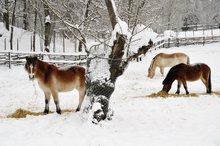According to AAEP, equine influenza, caused by the orthomyxovirus equine influenza A type 2 (A/equine 2), is one of the most common infectious diseases of the respiratory tract of horses. It is endemic in the equine population of the United States and throughout much of the world, with the notable exceptions of New Zealand and Iceland.

Protecting horses from equine influenza
All horses should be vaccinated against equine influenza unless they live in a closed and isolated facility.
Equine influenza virus does not constantly circulate, even in large groups of horses, but is sporadically introduced by an infected horse. This epidemiologic finding and the rapid elimination of the virus by the equine immune response suggest that infection can be avoided by preventing entry of the virus into an equine population by the quarantine of newly arriving horses for at least 14 days, and by appropriate vaccination before exposure.
All horses should be vaccinated against equine influenza unless they live in a closed and isolated facility.
To date, the most important factors associated with increased risk of infection have been identified as:
- Age: Horses 1 to 5 years old are more susceptible. Older horses are generally less susceptible to infection, but immunity can be overwhelmed in horses frequently exposed at shows or similar athletic events.
- Serum concentrations of influenza virus-specific antibody: The importance of local mucosal protection is difficult to quantitate by methods currently available.
- Frequent contact with large numbers of horses,
Equine influenza is highly contagious and the virus spreads rapidly through groups of horses in aerosolized droplets dispersed by coughing. The severity of clinical signs depends on the degree of existing immunity, among other factors.
Horses that are partially immune can become subclinically infected and shed virus. Immunity to the same (homologous) strain of virus following natural infection persists for approximately one year.
Immunity following vaccination with inactivated influenza vaccines can be short-lived, allowing recently vaccinated horses to become infected and shed virus, thereby contributing to maintenance and spread of infection within the equine population. For these reasons, only vaccines of proven efficacy should be selected for use.
Although influenza is endemic in many countries and circulates continuously in the equine population, explosive outbreaks occur at intervals of several years when the immunity of the equine population wanes, and sufficient changes in the virus has occurred, making the virus immune to a current vaccine.
To make sure your horse is protected, a regular vaccination schedule with a primary course of two doses, 3-6 weeks apart, followed by boosters at 6-12 month intervals, is generally suggested.
In many cases, such schedules may not maintain protective levels of the antibodies, and more frequent administration is advised in high risk situations where horses might be in contact with horses that have not been immunized. Your veterinarian will know what impact equine influenza is having in your area during the winter season.
Learn more about Equine Influenza
